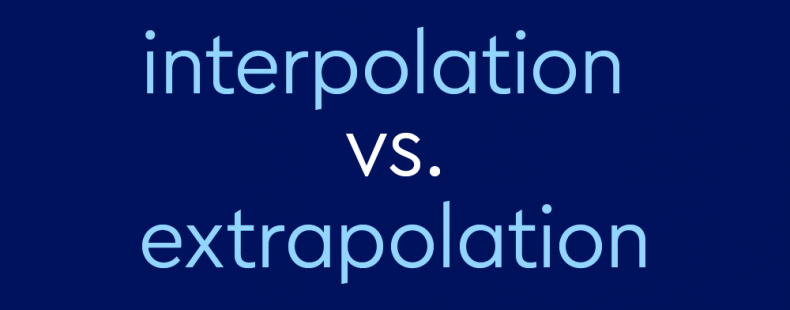The words interpolation and extrapolation may sound super technical, but they’re actually not all that complicated. Each term is used slightly differently depending on whether it’s being used generally or in the context of math and data science. But we’ll help you sort all that out.
In this article, we’ll discuss their more specific technical usage (hint: it tends to involve data sequences), cover the meanings of the base verbs interpolate and extrapolate, and provide some tips to help you remember the difference.
⚡ Quick summary
In a general sense, interpolation refers to inserting something between other things, while extrapolation refers to the act of making a conclusion about something unknown based on what is known. Mathematically speaking, interpolation is the process of determining an unknown value within a sequence based on other points in that set, while extrapolation is the process of determining an unknown value outside of a set based on the existing “curve.”
What is interpolation?
Interpolation, in the most general sense, is the act of introducing something extra (additional or extraneous) between other parts. The general sense of its verb form, interpolate, is similar in meaning to words like interject or interpose. Interpolation is often used in relation to texts, especially historical texts, to refer to the introduction of text within previously existing portions.
Interpolation is perhaps more commonly used in the context of math and data science. In this sense, interpolation involves determining a function’s value based on the value of other points. In other words, an unknown value within the sequence is determined based on what else is in the sequence. Determining a value in such a way can be called interpolating.
What is extrapolation?
Most generally, extrapolation means something similar to deduction—the act of making a conclusion about something unknown based on known information. The general sense of the base verb, extrapolate, is more commonly used and is similar to infer and deduce.
In math and data science, extrapolation involves estimating the value of a variable or function outside an observed range. So, to give a very simplified example, if a set of values includes 2, 4, 6, and 8, you might conclude that—if the curve were to continue in the same way—the next value would be 10. That’s extrapolation: you don’t know what the value will be with certainty, but you can make a good guess based on what you know about the nature of the sequence (or the trajectory of the curve).
Where do interpolation and extrapolation come from?
The words interpolation, interpolate, extrapolation, and extrapolate all have the same root, which comes from a Latin verb (polīre) meaning for “to polish.” That doesn’t have much bearing on their modern meanings, but there’s an important difference between each prefix: inter- means “between” or “among,” while extra- means “outside” or “beyond.”
Remembering the difference between these prefixes can be very helpful for remembering the difference between the two words.
Another pair of confusables worth increasing your knowledge on is inflation vs. deflation.
What is the difference between interpolation and extrapolation?
Let’s come back to math for a moment. Extrapolation is what happens when you’re given a sequence like 3, 6, 9, 12 and guess that the next value will be 15. Extrapolation in this sense, then, involves making a conclusion that’s outside or beyond the data set.
On the other hand, interpolation often involves filling in a blank (an unknown data point) within a data set—by making a conclusion about a value that’s inside the range or sequence.
Of course, in math it can be a lot more complicated than that, but that’s the approximate idea.
Examples of interpolation and extrapolation used in a sentence
Here are some example sentences that use interpolation and extrapolation in technical senses and more generally.
- Extrapolation of the curve suggests that temperatures will continue to rise over the next 20 years.
- An interpolation of the known values can help us determine the unknown data point in the set.
- The interpolation of quotes into the text helped to highlight the themes.
- That’s quite a clever extrapolation—you should be a detective.
- Logical extrapolation based on the ink and writing style leads us to conclude that this passage is a later interpolation, not contemporaneous with the original text.














